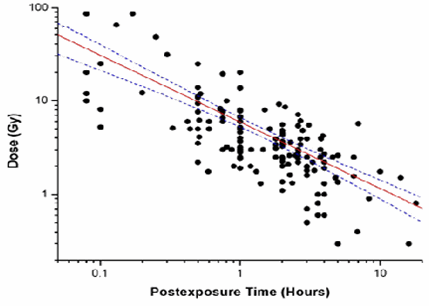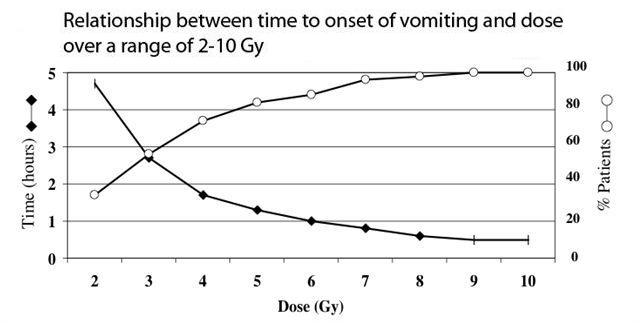About Time to Onset of Vomiting
Warning: cautions and limitations
- Vomiting is not specific for radiation exposure, especially in infants and children.
- It occurs with many clinical disorders as well with mass casualty events involving
- Physical trauma
- Psychological stress
- Biological threats
- Chemical threats
- The vomiting algorithm in this tool was provided by AFRRI and is based on the AFRRI BAT program.
- Used alone, time to onset of vomiting provides an imperfect estimation of radiation absorbed dose, but initially may be the only clinical information available.
- Thus, time to onset of vomiting following exposure should be used with caution, and in conjunction with clinical signs and symptoms and other biodosimetry information.
(See radiation exposure algorithm) - See detailed clinical caveats in:
- Demidenko E, Williams BB, Swartz HM. Radiation dose prediction using data on time to emesis in the case of nuclear terrorism. Radiat Res 2009 Mar; 171(3):310-9. [PubMed Citation]
Background information 2-7
- After exposure to radiation, victims may vomit.
- The amount, severity, and time to onset of vomiting are related to the dose received, the dose rate, and what parts of the body (or the whole body) were irradiated.
- In general, the higher the radiation dose absorbed, the greater the severity of symptoms and the more rapid the onset of vomiting.
- Radiation-induced vomiting occurs as a result of effects on the central nervous system and on the GI tract.
Illustrations
Radiation Dose vs. Time to Onset of Vomiting

Notes on the graph above:
- Graph uses a log scale on both the x- and y-axes.
- Each plotted point represents a unique patient.
- Doses were estimated at "midline" of the body for each patient.
- Dose rates used to create this graph range from very high doses in accident cases to 0.3 Gy/min in radiotherapy patients.
- The red line represents the best fit line for the composite data.
- The dotted blue lines represent the 95% confidence limits around this value.
- AFRRI BAT software application
- Anno GH, Baum SJ, Withers HR, Young RW. Symptomatology of acute radiation effects in humans after exposure to doses of 0.5-30 Gy. Health Phys. 1989 Jun;56(6):821-38. [PubMed Citation]
- Goans RE, Clinical care of the radiation-accident patient: patient presentation, assessment, and initial diagnosis. In: Ricks RC, Berger ME, Ohara FM, Jr. (eds) The Medical Basis for Radiation-Accident Preparedness, The Clinical Care of Victims, Proceedings of the 4th International Conference REAC/TS Conference on The Medical Basis of Radiation Accident Preparedness, Orlando, FL, March 2001. Boca Raton, FL: The Parthenon Publishing Group.

Notes on the graph above:
- Left y-axis reflects time (in hours) to onset of vomiting after a radiation event.
- Right y-axis reflects percent of patients expected to vomit at a particular radiation dose.
- X-axis reflects estimated whole body dose received (measured in gray).
- Triage, Monitoring and Treatment of people exposed to ionising radiation following a malevolent act (PDF - 11 MB) (TMT Handbook Partners, March 2009) See page 99.
References
- Camarata AS, Switchenko JM, Demidenko E, Flood AB, Swartz HM, Ali AN. Emesis as a Screening Diagnostic for Low Dose Rate (LDR) Total Body Radiation Exposure. Health Phys. 2016 Apr;110(4):391-4. [PubMed Citation]
- Demidenko E, Williams BB, Swartz HM. Radiation dose prediction using data on time to emesis in the case of nuclear terrorism. Radiat Res 2009 Mar; 171(3):310-9. [PubMed Citation]
- Parker DD, Parker JC. Estimating radiation dose from time to emesis and lymphocyte depletion. Health Phys. 2007 Dec;93(6):701-4. [PubMed Citation]
- Waselenko JK, MacVittie TJ, Blakely WF, Pesik N, Wiley AL, Dickerson WE, Tsu H, Confer DL, Coleman CN, Seed T, Lowry P, Armitage JO, Dainiak N; Strategic National Stockpile Radiation Working Group. Medical management of the acute radiation syndrome: recommendations of the Strategic National Stockpile Radiation Working Group. Annals of Internal Medicine 2004; Vol. 140:1037-51. [PubMed Citation]
- NATO Handbook on the Medical Aspects of NBC Defensive Operations AMedP-6(B), Chapter 6, General Medical Effects of Nuclear Weapons: Diagnosis, Treatment, and Prognosis, 1 February, 1996.
- Time/Dose Effects in Acute Radiation Syndrome - Acute Clinical Effects of Single-Dose Exposure of Whole-Body Irradiation
- Time Phases of the Acute Radiation Syndrome (ARS)
- Armed Forces Radiobiology Research Institute (AFRRI) - Biodosimetry Assessment Tool (BAT)
- Diagnosis and Treatment of Radiation Injuries (PDF - 202 KB) (IAEA Safety Reports Series No. 2, Vienna 1998)
See also:

